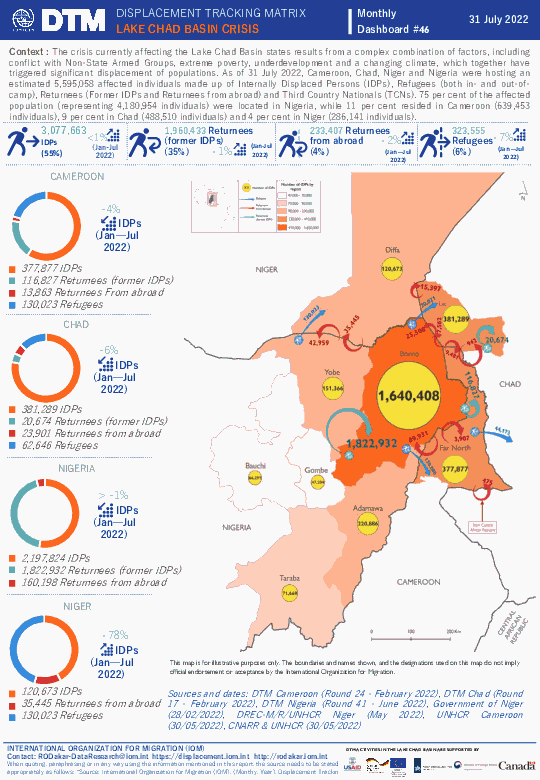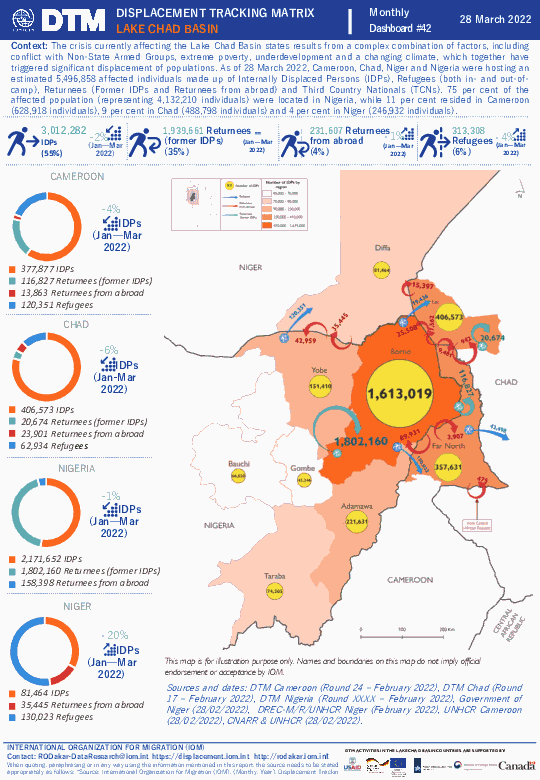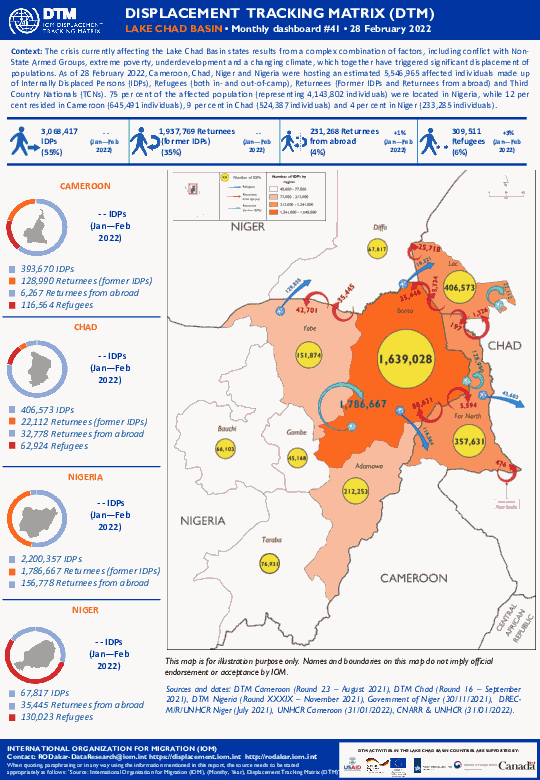-
Countries
-
Data and Analysis
-
Special Focus
-
Crisis Responses
Lake Chad Basin Crisis Monthly Dashboard
Title Standard
West and Central Africa — Lake Chad Basin Crisis Monthly Dashboard # (DATE)
Operation
Contact
Regional Office Dakar, RODakar-DataResearch@iom.int
Type
Component
Domain
Confidential
Region
The crisis currently affecting the Lake Chad Basin states results from a complex combination of factors, including conflict with Non-State Armed Groups, extreme poverty, underdevelopment and a changing climate, which together have triggered significant displacement of populations. As of 31 July 2022, Cameroon, Chad, Niger and Nigeria were hosting an estimated 5,595,058 affected individuals made up of Internally Displaced Persons (IDPs), Refugees (both in- and out-of-camp), Returnees (Former IDPs and Returnees from abroad) and Third Country Nationals (TCNs). 75 per cent of the affected population (representing 4,180,954 individuals) were located in Nigeria, while 11 per cent resided in Cameroon (639,453 individuals), 9 per cent in Chad (488,510 individuals) and 5 per cent in Niger (286,141 individuals).
The crisis currently affecting the Lake Chad Basin states results from a complex combination of factors, including conflict with Non-State Armed Groups, extreme poverty, underdevelopment and a changing climate, which together have triggered significant displacement of populations. As of 30 June 2022, Cameroon, Chad, Niger and Nigeria were hosting an estimated 5,595,800 affected individuals made up of Internally Displaced Persons (IDPs), Refugees (both in- and out-of-camp), Returnees (Former IDPs and Returnees from abroad) and Third Country Nationals (TCNs). 75 per cent of the affected population (representing 4,180,954 individuals) were located in Nigeria, while 11 per cent resided in Cameroon (638,647 individuals), 9 per cent in Chad (490,058 individuals) and 4 per cent in Niger (286,141 individuals).
The crisis currently affecting the Lake Chad Basin states results from a complex combination of factors, including conflict with Non-State Armed Groups, extreme poverty, underdevelopment and a changing climate, which together have triggered significant displacement of populations. As of 25 May 2022, Cameroon, Chad, Niger and Nigeria were hosting an estimated 5,503,092 affected individuals made up of Internally Displaced Persons (IDPs), Refugees (both in- and out-of-camp), Returnees (Former IDPs and Returnees from abroad) and Third Country Nationals (TCNs). 75 per cent of the affected population (representing 4,132,210 individuals) were located in Nigeria, while 12 per cent resided in Cameroon (634,189 individuals), 9 per cent in Chad (489,761 individuals) and 4 per cent in Niger (246,932 individuals).
The crisis currently affecting the Lake Chad Basin states results from a complex combination of factors, including conflict with Non-State Armed Groups, extreme poverty, underdevelopment and a changing climate, which together have triggered significant displacement of populations. As of 30 April 2022, Cameroon, Chad, Niger and Nigeria were hosting an estimated 5,501,412 affected individuals made up of Internally Displaced Persons (IDPs), Refugees (both in- and out-of-camp), Returnees (Former IDPs and Returnees from abroad) and Third Country Nationals (TCNs). 75 per cent of the affected population (representing 4,132,210 individuals) were located in Nigeria, while 12 per cent resided in Cameroon (633,472 individuals), 9 per cent in Chad (488,798 individuals) and 4 per cent in Niger (246,932 individuals)
The crisis currently affecting the Lake Chad Basin states results from a complex combination of factors, including conflict with Non-State Armed Groups, extreme poverty, underdevelopment and a changing climate, which together have triggered significant displacement of populations. As of 28 March 2022, Cameroon, Chad, Niger and Nigeria were hosting an estimated 5,496,858 affected individuals made up of Internally Displaced Persons (IDPs), Refugees (both in- and out-of-camp), Returnees (Former IDPs and Returnees from abroad) and Third Country Nationals (TCNs). 75 per cent of the affected population (representing 4,132,210 individuals) were located in Nigeria, while 11 per cent resided in Cameroon (628,918 individuals), 9 per cent in Chad (488,798 individuals) and 4 per cent in Niger (246,932 individuals).
The crisis currently affecting the Lake Chad Basin states results from a complex combination of factors, including conflict with Non-State Armed Groups, extreme poverty, underdevelopment and a changing climate, which together have triggered significant displacement of populations. As of 28 February 2022, Cameroon, Chad, Niger and Nigeria were hosting an estimated 5,546,965 affected individuals made up of Internally Displaced Persons (IDPs), Refugees (both in- and out-of-camp), Returnees (Former IDPs and Returnees from abroad) and Third Country Nationals (TCNs). 75 per cent of the affected population (representing 4,143,802 individuals) were located in Nigeria, while 12 per cent resided in Cameroon (645,491 individuals), 9 per cent in Chad (524,387 individuals) and 4 per cent in Niger (233,285 individuals). The crisis currently affecting the Lake Chad Basin states results from a complex combination of factors, including conflict with Non-State Armed Groups, extreme poverty, underdevelopment and a changing climate, which together have triggered significant displacement of populations. As of 28 February 2022, Cameroon, Chad, Niger and Nigeria were hosting an estimated 5,546,965 affected individuals made up of Internally Displaced Persons (IDPs), Refugees (both in- and out-of-camp), Returnees (Former IDPs and Returnees from abroad) and Third Country Nationals (TCNs). 75 per cent of the affected population (representing 4,143,802 individuals) were located in Nigeria, while 12 per cent resided in Cameroon (645,491 individuals), 9 per cent in Chad (524,387 individuals) and 4 per cent in Niger (233,285 individuals).
The crisis currently affecting the Lake Chad Basin states results from a complex combination of factors, including conflict with Non-State Armed Groups, extreme poverty, underdevelopment and a changing climate, which together have triggered significant displacement of populations. As of 25 January 2022, Cameroon, Chad, Niger and Nigeria were hosting an estimated 5,536,188 affected individuals made up of Internally Displaced Persons (IDPs), Refugees (both in- and out-of-camp), Returnees (Former IDPs and Returnees from abroad) and Third Country Nationals (TCNs). 75 per cent of the affected population (representing 4,143,802 individuals) were located in Nigeria, while 12 per cent resided in Cameroon (645,491 individuals), 9 per cent in Chad (513,798 individuals) and 4 per cent in Niger (233,097 individuals).
The crisis currently affecting the Lake Chad Basin states results from a complex combination of factors, including conflict with Non-State Armed Groups, extreme poverty, underdevelopment and a changing climate, which together have triggered significant displacement of populations. As of 22 December 2021, Cameroon, Chad, Niger and Nigeria were hosting an estimated 5,462,244 affected individuals made up of Internally Displaced Persons (IDPs), Refugees (both in- and out-of-camp), Returnees (Former IDPs and Returnees from abroad) and Third Country Nationals (TCNs). 76 per cent of the affected population (representing 4,143,802 individuals) were located in Nigeria, while 11 per cent resided in Cameroon (608,076 individuals), 9 per cent in Chad (477,269 individuals) and 4 per cent in Niger (233,097 individuals).
The crisis currently affecting the Lake Chad Basin states results from a complex combination of factors, including conflict with Non-State Armed Groups, extreme poverty, underdevelopment and a changing climate, which together have triggered significant displacement of populations. As of 26 November 2021, Cameroon, Chad, Niger and Nigeria were hosting an estimated 5,418,236 affected individuals made up of Internally Displaced Persons (IDPs), Refugees (both in- and out-of-camp), Returnees (Former IDPs and Returnees from abroad) and Third Country Nationals (TCNs). 76 per cent of the affected population (representing 4,100,676 individuals) were located in Nigeria, while 11 per cent resided in Cameroon (607,520 individuals), 9 per cent in Chad (476,943 individuals) and 4 per cent in Niger (233,097 individuals).
The crisis currently affecting the Lake Chad Basin states results from a complex combination of factors, including conflict with Non-State Armed Groups, extreme poverty, underdevelopment and a changing climate, which together have triggered significant displacement of populations. As of 31 October 2021, Cameroon, Chad, Niger and Nigeria were hosting an estimated 5,417,841 affected individuals made up of Internally Displaced Persons (IDPs), Refugees (both in- and out-of-camp), Returnees (Former IDPs and Returnees from abroad) and Third Country Nationals (TCNs). 76 per cent of the affected population (representing 4,100,676 individuals) were located in Nigeria, while 11 per cent resided in Cameroon (607,520 individuals), 9 per cent in Chad (476,548 individuals) and 4 per cent in Niger (233,097 individuals).
Pagination
- Previous page
- Page 2
- Next page










